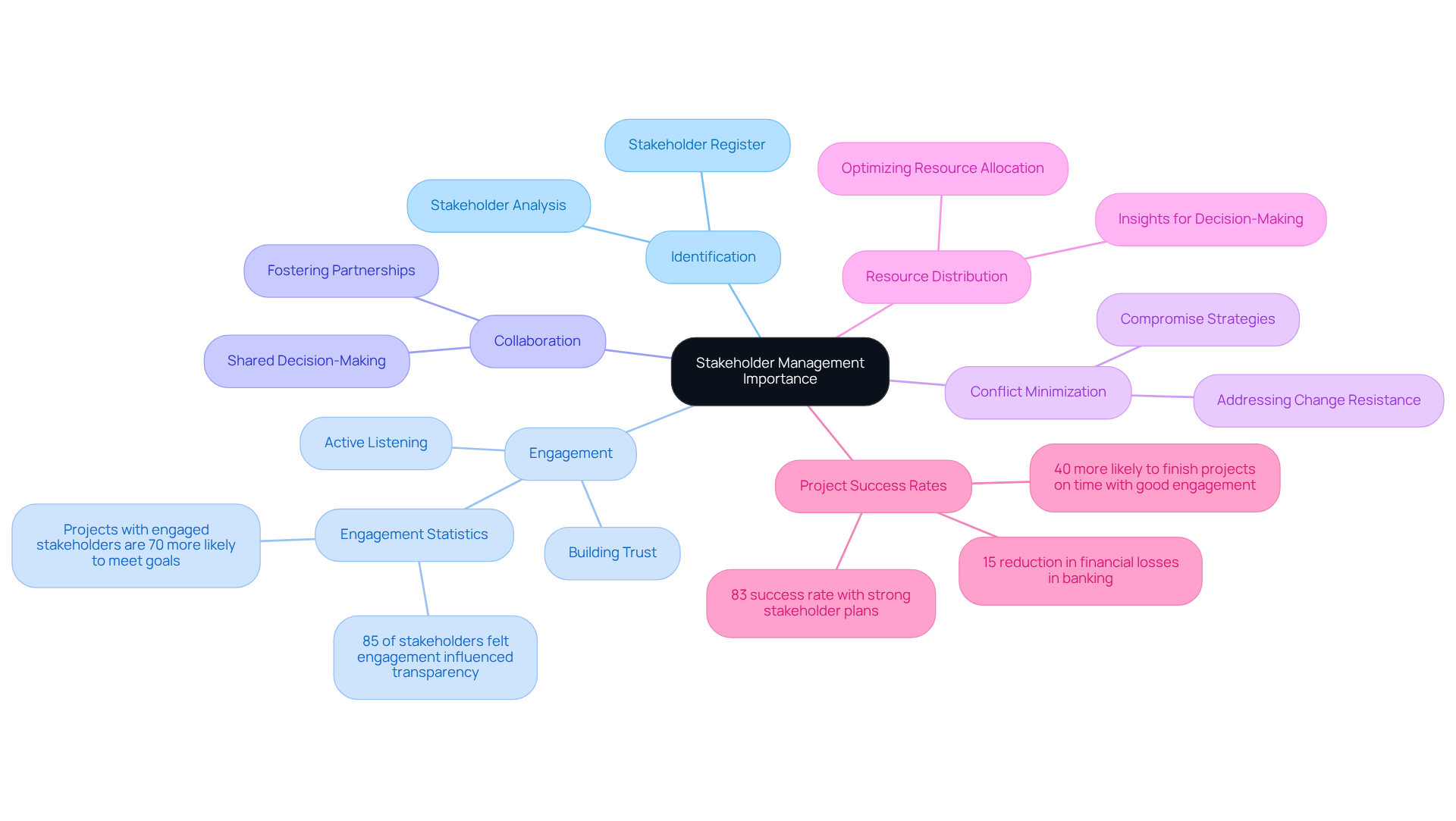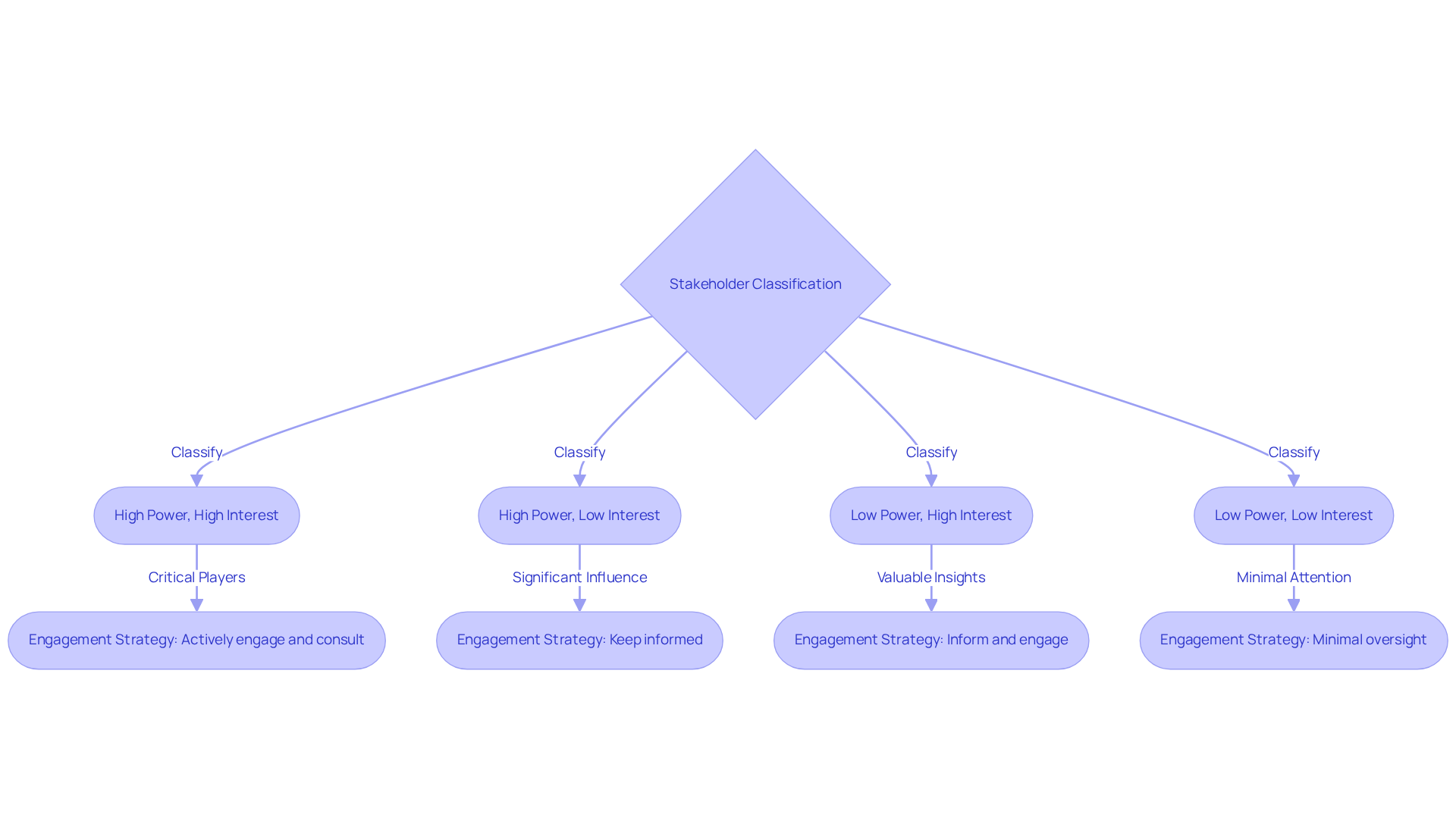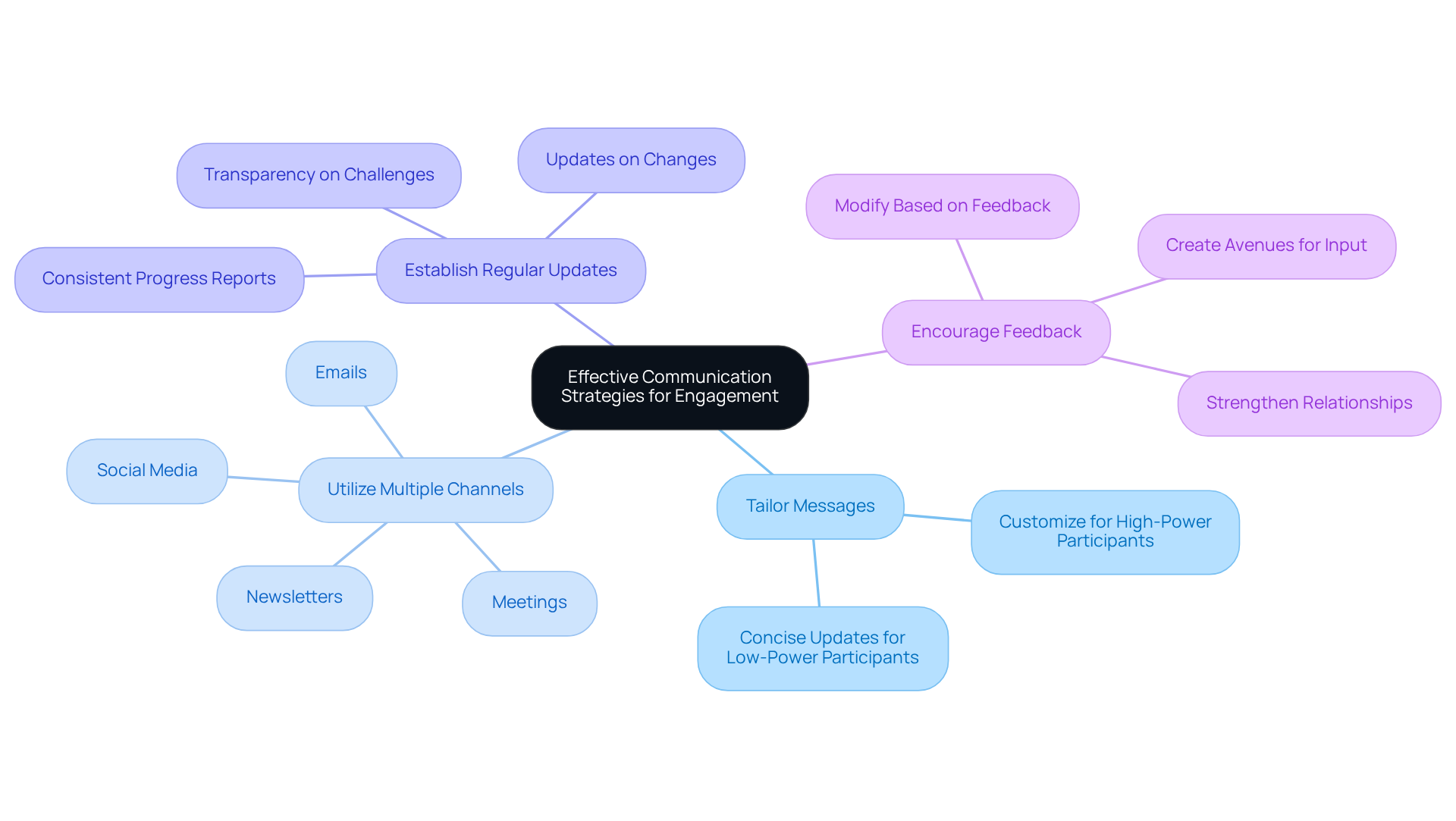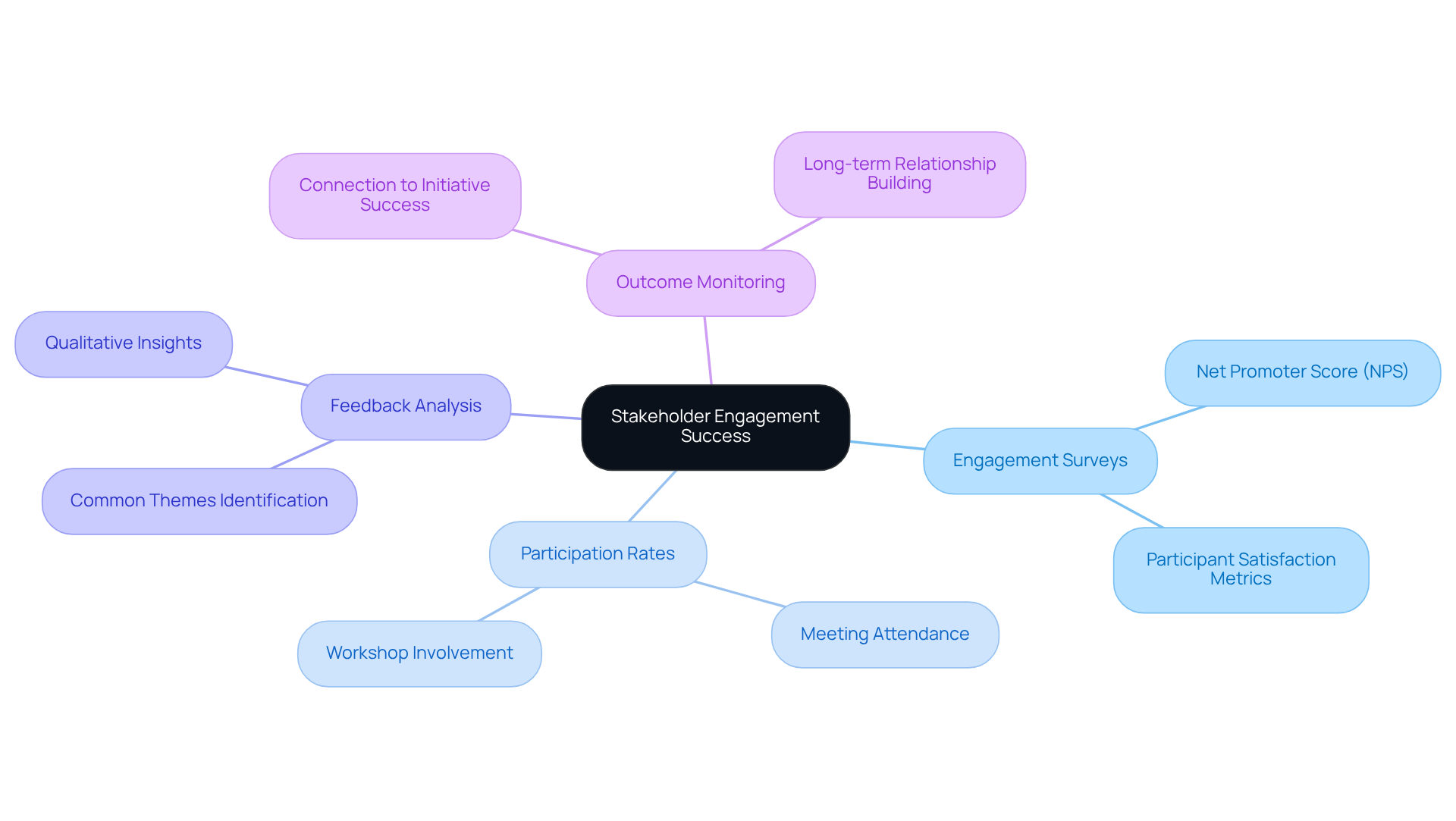Overview
Effective cross-functional stakeholder management is essential for organizational success and involves four key steps:
- Understanding stakeholder importance
- Identifying and categorizing stakeholders
- Developing tailored communication strategies
- Measuring engagement success
By systematically engaging stakeholders based on their influence and interest, organizations can enhance collaboration, improve project outcomes, and build lasting relationships. This strategic approach ultimately leads to better performance. To achieve these results, it is crucial to implement these steps thoughtfully and consistently, ensuring that all stakeholders are effectively engaged.
Introduction
Effective cross-functional stakeholder management is the backbone of successful initiatives. Yet, many organizations struggle to navigate the complexities involved. By understanding and engaging with stakeholders—ranging from employees to investors—companies can align their goals and foster collaboration, ultimately enhancing outcomes.
However, how can organizations ensure that they not only identify but also effectively communicate with and measure the success of these diverse groups? This article delves into four essential steps that empower organizations to master stakeholder management, paving the way for sustainable growth and improved project success.
Understand the Importance of Stakeholder Management
The success of any initiative relies on cross functional stakeholder management, which involves the identification, analysis, and engagement of individuals or groups with a vested interest in the outcome. Effective management through cross functional stakeholder management aligns all parties with the initiative's goals, enhancing collaboration and minimizing potential conflicts.
In turnaround and restructuring situations, cross functional stakeholder management and understanding participant dynamics are vital. Engaging in cross functional stakeholder management with creditors, employees, and customers during financial difficulties can lead to solutions that satisfy all involved. in cross functional stakeholder management builds trust and facilitates smoother transitions during challenging periods. Research indicates that projects with robust participant plans succeed 83% of the time, compared to only 32% for those lacking such plans.
Moreover, prioritizing cross functional stakeholder management can enhance resource distribution, as these stakeholders often provide insights that guide decision-making. Companies that actively engage with interested parties tend to perform 15% better in . By concentrating on participant involvement, organizations can establish a strong framework for cross functional stakeholder management during crises, ultimately resulting in improved outcomes and lasting sustainable growth. Transform Your Small/Medium Business emphasizes the importance of decisive action and collaborative strategies, including interim management services and financial assessments, which are crucial for stabilizing financial positions and enhancing operations during these critical times.

Identify and Categorize Key Stakeholders
Effective management of interested parties begins with the recognition and classification of stakeholders based on their influence and interest in the initiative, which is essential for cross functional stakeholder management. This process can be significantly enhanced through a mapping exercise that plots participants on a grid evaluating their power and interest levels.
- High Power, High Interest: These stakeholders are critical players who must be actively engaged and consulted throughout the project. In a restructuring scenario, this group typically includes senior management and major investors, whose support is vital for success. Our team advocates for a shortened decision-making cycle throughout the turnaround process, empowering your team to take decisive action to preserve your business.
- High Power, Low Interest: Stakeholders in this category should be kept informed but do not require extensive involvement. Regulatory bodies and external auditors often fall into this group, as their influence is significant, yet their interest may be limited.
- Low Power, High Interest: This group should be adequately informed and engaged, as they can provide valuable insights. Employees and customers often belong to this category, and their feedback can enhance results. Engaging essential employees in stakeholder interaction increases the likelihood of transformations by four times, underscoring their importance in achieving favorable outcomes. We continually monitor the success of our plans through our client dashboard, which offers to assess your business health.
- Low Power, Low Interest: Stakeholders in this context require minimal oversight, enabling teams to concentrate their efforts on more significant groups.
By effectively classifying interested parties, organizations can improve their cross functional stakeholder management by tailoring communication and engagement strategies to ensure that each group receives the appropriate level of attention and information. This focused strategy not only nurtures stronger partnerships but also facilitates more seamless execution, ultimately enhancing the chances of achieving objectives.

Develop Effective Communication Strategies for Engagement
Effective communication strategies are essential for engaging interested parties and ensuring cross functional stakeholder management to secure their support throughout the project lifecycle. Consider these key best practices:
- Tailor Messages: Customize communication according to the category of the interested party. High-power participants may require comprehensive reports, while low-power participants might benefit from concise updates. This targeted approach ensures that each group receives relevant information that meets their needs.
- Utilize Multiple Channels: Employ a variety of , including emails, meetings, newsletters, and social media. This multi-channel approach improves message delivery and understanding, ensuring that interested parties are well-informed.
- Establish Regular Updates: Arrange consistent updates to keep interested parties informed about progress, challenges, and changes. Transparency builds trust and promotes continuous involvement, which is essential for success.
- Encourage Feedback: Create avenues for participants to provide input and express concerns. This two-way communication not only strengthens relationships but also permits modifications based on participant feedback, enhancing overall alignment of the initiative.
Employing these communication tactics can greatly enhance relationships through cross functional stakeholder management, resulting in greater support and cooperation during essential initiatives. Studies show that organizations with efficient communication strategies can enhance project achievement rates by as much as 38%, underscoring the significance of these practices in attaining desired results.

Measure and Evaluate Stakeholder Engagement Success
Assessing and analyzing participant involvement success is essential for efficient management. To enhance stakeholder management practices, consider the following key metrics and evaluation techniques, aligned with the 'Identify & Plan' and 'Test & Measure' frameworks:
- Engagement Surveys: Implement surveys to measure participant satisfaction and evaluate the effectiveness of communication strategies. Utilizing metrics such as can yield valuable insights that highlight areas needing improvement, allowing for informed planning and adjustments.
- Participation Rates: Monitor attendance and involvement in meetings, workshops, and other activities. High participation rates typically reflect strong interest and commitment from involved parties, indicating successful engagement efforts. This information can guide strategic planning and decision-making processes, ensuring alignment with the needs of interested parties.
- Feedback Analysis: Conduct a thorough examination of participant feedback to uncover common themes and concerns. This qualitative information is crucial for guiding modifications to involvement strategies, ensuring they align with participant needs. By consistently assessing contributor feedback, organizations can implement lessons learned and improve interaction effectiveness.
- Outcome Monitoring: Monitor results and relate them to levels of participant involvement. Grasping the connection between involvement and initiative success can offer essential insights for enhancing future strategies. This method endorses a dedication to implementing insights gained from the engagement process, ultimately nurturing strong, enduring connections with involved parties.
By employing these measurement techniques, organizations can enhance their cross functional stakeholder management practices, ensuring alignment with project goals and fostering continuous improvement.

Conclusion
Effective cross-functional stakeholder management is crucial for the success of any initiative, as it fosters collaboration and alignment among all parties involved. By understanding the dynamics of stakeholder engagement, organizations can navigate challenges more effectively, build trust, and achieve desired outcomes. This proactive approach not only enhances the likelihood of project success but also contributes to sustainable growth.
The article highlights several key strategies for successful stakeholder management:
- Identifying and categorizing stakeholders based on their influence and interest.
- Developing tailored communication strategies.
- Measuring engagement success.
By employing these best practices, organizations can ensure that they effectively engage with critical stakeholders, maintain transparency, and adapt their strategies based on feedback. The statistics presented underscore the significant impact that robust stakeholder management can have on project outcomes and overall organizational performance.
Ultimately, prioritizing effective cross-functional stakeholder management is not just a best practice; it is a strategic imperative that can lead to improved decision-making, stronger relationships, and successful project execution. Organizations are encouraged to take decisive action in implementing these strategies, recognizing that the investment in stakeholder engagement will yield substantial returns in both performance and resilience. Embracing this approach will not only enhance current initiatives but also lay the groundwork for future successes in an ever-evolving landscape.
Frequently Asked Questions
What is cross functional stakeholder management?
Cross functional stakeholder management involves the identification, analysis, and engagement of individuals or groups with a vested interest in an initiative's outcome, ensuring that all parties are aligned with the initiative's goals.
Why is stakeholder management important in turnaround and restructuring situations?
In turnaround and restructuring situations, effective stakeholder management is vital as it helps engage creditors, employees, and customers, leading to solutions that satisfy all involved and facilitating smoother transitions during challenging periods.
What impact does robust participant planning have on project success?
Research indicates that projects with robust participant plans succeed 83% of the time, while those lacking such plans only succeed 32% of the time.
How does stakeholder engagement affect resource distribution?
Prioritizing stakeholder engagement enhances resource distribution, as stakeholders often provide valuable insights that guide decision-making.
What performance improvements can companies expect from active stakeholder engagement?
Companies that actively engage with stakeholders tend to perform 15% better in their strategic plans compared to those that do not.
What strategies can help stabilize financial positions during crises?
Decisive action and collaborative strategies, including interim management services and financial assessments, are crucial for stabilizing financial positions and enhancing operations during critical times.




